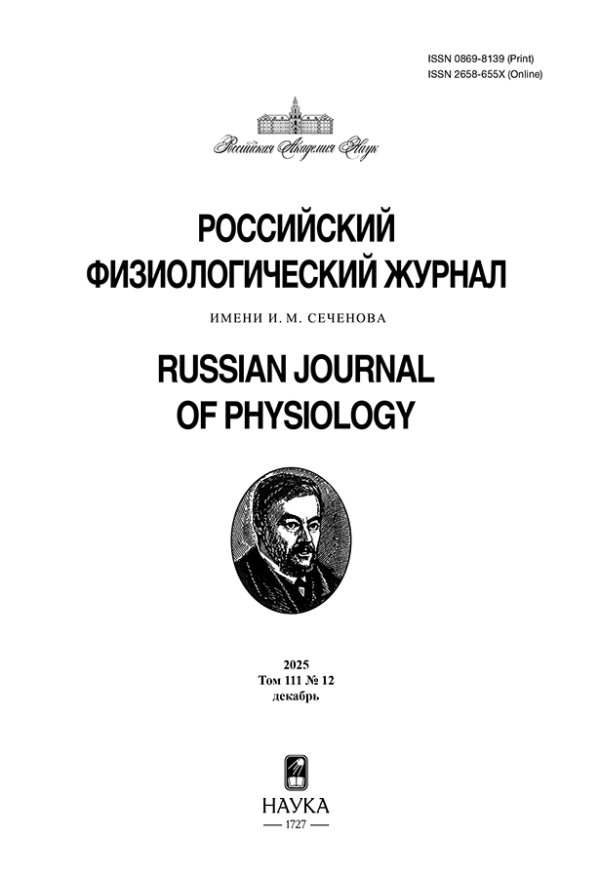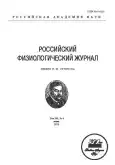Влияние гибернации на электрическую активность и калиевые токи в миокарде длиннохвостого суслика
- Авторы: Филатова Т.С.1, Абрамочкин Д.В.1
-
Учреждения:
- Кафедра физиологии человека и животных, биологический факультет, Московский государственный университет им. М.В. Ломоносова
- Выпуск: Том 109, № 6 (2023)
- Страницы: 788-797
- Раздел: ЭКСПЕРИМЕНТАЛЬНЫЕ СТАТЬИ
- URL: https://journals.rcsi.science/0869-8139/article/view/137957
- DOI: https://doi.org/10.31857/S0869813923060031
- EDN: https://elibrary.ru/WGZKYU
- ID: 137957
Цитировать
Полный текст
Аннотация
Гибернирующие млекопитающие способны снижать температуру своего тела до значений, близких к 0°C. При этом их сердце чрезвычайно устойчиво к развитию аритмий, вызванных снижением температуры. В данной работе впервые были исследованы калиевые токи в миокарде зимоспящего млекопитающего на примере длиннохвостого суслика (Citellus undulatus) и их изменение при гибернации. С помощью метода пэтч-кламп были исследованы транзиторный выходящий ток Ito и фоновый ток входящего выпрямления IK1 в изолированных желудочковых и предсердных кардиомиоцитах летних (активных) и зимних (гибернирующих) сусликов. В работе выявлено, что при комнатной температуре, при положительных поддерживаемых потенциалах пиковая амплитуда тока Ito в кардиомиоцитах гибернирующей группы животных статистически значимо ниже, чем таковая у летней группы. Подавление тока Ito при гибернации было выражено сильнее в желудочковом миокарде по сравнению с предсердным. Фоновый ток входящего выпрямления IK1 при адаптации к гибернации усиливался в желудочковом миокарде зимней группы животных. В предсердном миокарде статистически значимых различий тока IK1 между группами не было обнаружено. Также в работе регистрировали потенциалы действия в изолированных желудочковых кардиомиоцитах. Длительность потенциалов действия на уровнях реполяризации 50 и 90% не различалась между группами, также не было выявлено различий в максимальной скорости нарастания переднего фронта потенциалов действия и уровне потенциала покоя. В совокупности, выявленные различия в амплитуде токов Ito и IK1 между активными и гибернирующими сусликами могут способствовать увеличению длительности рефрактерного периода и поддержанию потенциала покоя при низкой температуре.
Ключевые слова
Об авторах
Т. С. Филатова
Кафедра физиологии человека и животных, биологический факультет,Московский государственный университет им. М.В. Ломоносова
Email: abram340@mail.ru
Россия, Москва
Д. В. Абрамочкин
Кафедра физиологии человека и животных, биологический факультет,Московский государственный университет им. М.В. Ломоносова
Автор, ответственный за переписку.
Email: abram340@mail.ru
Россия, Москва
Список литературы
- Lyman CP, Chatfield PO (1955) Physiology of Hibernation in Mammals. Phys Rev 35: 403–425. https://doi.org/10.1152/PHYSREV.1955.35.2.403
- Barnes BM (1989) Freeze Avoidance in a Mammal: Body Temperatures Below 0°C in an Arctic Hibernator. Science 244: 1593–1595. https://doi.org/10.1126/SCIENCE.2740905
- Andrews MT (2007) Advances in molecular biology of hibernation in mammals. BioEssays 29: 431–440. https://doi.org/10.1002/BIES.20560
- Johansson BW (1996) The hibernator heart – Nature’s model of resistance to ventricular fibrillation. Cardiovasc Res 31: 826–832. https://doi.org/10.1016/S0008-6363(95)00192-1
- Burlington RF, Darvish A (1988) Low-Temperature Performance of Isolated Working Hearts from a Hibernator and a Nonhibernator. Physiol Zool 61: 387–395. https://doi.org/10.1086/PHYSZOOL.61.5.30161260
- White JD (1980) Cardiac Arrest in Hypothermia. JAMA 244: 2262–2262. https://doi.org/10.1001/JAMA.1980.03310200014007
- Johansson BW (1985) Ventricular Repolarization and Fibrillation Threshold in Hibernating Species. Eur Heart J 6: 53–62. https://doi.org/10.1093/EURHEARTJ/6.SUPPL_D.53
- Egorov YV, Glukhov AV, Efimov IR, Rosenshtraukh LV (2012) Hypothermia-induced spatially discordant action potential duration alternans and arrhythmogenesis in nonhibernating versus hibernating mammals. Am J Physiol – Hear Circ Physiol 303(8): H1035–H1046. https://doi.org/10.1152/AJPHEART.00786.2011/ASSET/IMAGES/LARGE/ZH40201205500008.JPEG
- Fedorov VV, Glukhov AV, Sudharshan S, Egorov Y, Rosenshtraukh LV, Efimov IR (2008) Electrophysiological mechanisms of antiarrhythmic protection during hypothermia in winter hibernating versus nonhibernating mammals. Hear Rhythm 5: 1587–1596. https://doi.org/10.1016/J.HRTHM.2008.08.030
- Kuzmin VS, Abramov AA, Egorov YV, Rosenshtraukh LV (2019) Hypothermia-Induced Postrepolarization Refractoriness Is the Reason of the Atrial Myocardium Tolerance to the Bioelectrical Activity Disorders in the Hibernating and Active Ground Squirrel Citellus undulatus. Dokl Biol Sci 486: 63–68. https://doi.org/10.1134/S0012496619030050/FIGURES/3
- Kuz’min VS, Abramov AA, Egorov IV, Rozenshtraukh LV (2014) Hypothermia induced alteration of refractoriness in the ventricular myocardium of ground souirrel Citellus undulatus. Ross Fiziol Zhurnal Im IM Sechenova 100: 1399–1408.
- Alekseev AE, Markevich NI, Korystova AF, Terzic A, Kokoz YM (1996) Comparative analysis of the kinetic characteristics of L-type calcium channels in cardiac cells of hibernators. Biophys J 70: 786–797. https://doi.org/10.1016/S0006-3495(96)79618-2
- Abramochkin DV, Filatova TS, Pustovit KB, Dzhumaniiazova I, Karpushev AV (2021) Small G—protein RhoA is a potential inhibitor of cardiac fast sodium current. J Physiol Biochem 77: 13–23. https://doi.org/10.1007/s13105-020-00774-w
- Isenberg G, Klockner U (1982) Calcium tolerant ventricular myocytes prepared by preincubation in a “KB medium.” Pflügers Arch Eur J Physiol 395: 6–18. https://doi.org/10.1007/BF00584963
- Yue L, Feng J, Li GR, Nattel S (1996) Transient outward and delayed rectifier currents in canine atrium: properties and role of isolation methods. Am J Physiol Circ Physiol 270: H2157–H2168. https://doi.org/10.1152/AJPHEART.1996.270.6.H2157
- Ibarra J, Morley GE, Delmar M (1991) Dynamics of the inward rectifier K+ current during the action potential of guinea pig ventricular myocytes. Biophys J 60: 1534–1539. https://doi.org/10.1016/S0006-3495(91)82187-7
- Apkon M, Nerbonne JM (1991) Characterization of two distinct depolarization-activated K+ currents in isolated adult rat ventricular myocytes. J Gen Physiol 97: 973–1011. https://doi.org/10.1085/JGP.97.5.973
- Linz KW, Meyer R (2000) Profile and kinetics of L-type calcium current during the cardiac ventricular action potential compared in guinea-pigs, rats and rabbits. Pflügers Arch 439: 588–599. https://doi.org/10.1007/S004249900212
- Dong M, Yan S, Chen Y, Niklewski PJ, Sun X, Chenault K, Wang HS (2010) Role of the Transient Outward Current in Regulating Mechanical Properties of Canine Ventricular Myocytes. J Cardiovasc Electrophysiol 21: 697–703. https://doi.org/10.1111/J.1540-8167.2009.01708.X
- Liu B, Arlock P, Wohlfart B, Johansson BW (1991) Temperature effects on the Na and Ca currents in rat and hedgehog ventricular muscle. Cryobiology 28: 96–104. https://doi.org/10.1016/0011-2240(91)90011-C
- Wilson JR, Clark RB, Banderali U, Giles WR (2011) Measurement of the membrane potential in small cells using patch clamp methods. Channels 5: 530. https://doi.org/10.4161/CHAN.5.6.17484
Дополнительные файлы













